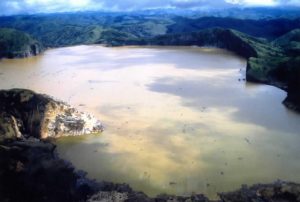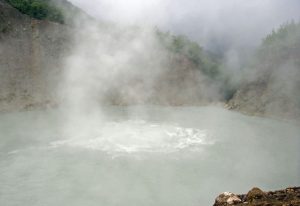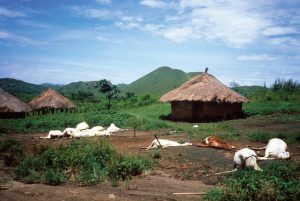 Natural disasters happen all the time…every day for that matter. Many of these disasters cannot be predicted, or can only be predicted a few minutes to hours before the disaster arrives. That was not the case with the Limnic eruption that happened at Lake Nyos in Cameroon, on August 21, 1986…or was it. A Limnic eruption is a eruption of gas rather than lava or ash, and the gasses can be deadly.
Natural disasters happen all the time…every day for that matter. Many of these disasters cannot be predicted, or can only be predicted a few minutes to hours before the disaster arrives. That was not the case with the Limnic eruption that happened at Lake Nyos in Cameroon, on August 21, 1986…or was it. A Limnic eruption is a eruption of gas rather than lava or ash, and the gasses can be deadly.
The eruption of lethal gas came from Lake Nyos at 9:30pm on that August day in 1986, took the lives of 2,000 people in the nearby villages, including Lower Nyos. The eruption wiped out four villages too. Carbon Dioxide, while natural to the earth, and even a part of the life process, becomes deadly if there is too much of it. Because Lake Nyos and Lake Monoun are crater lakes, the possibility exists for gasses to escape from the volcanos below them. The lakes are both about a mile square, and are located in the remote mountains of northwestern Cameroon. The area is beautiful with great rock cliffs and lush green vegetation.
Prior to the eruption, there were signs of impending disaster. In August 1984, 37 people near Lake Monoun died suddenly, but the incident was largely covered up by the government. The remoteness and lack of services made the incidents easier to cover up. Since there is no electricity or telephone service in the area, it was not difficult to keep the incident under wraps, and the 5,000 people who lived in villages near Lake Nyos simply had no idea that there was a very real danger of their own lake producing the same dangerous gas. I’m not  certain why they would want to keep the matter a secret, other that to avoid causing a panic, but the plan was fraught with disaster. Had the people known, maybe they could have left the area and survived.
certain why they would want to keep the matter a secret, other that to avoid causing a panic, but the plan was fraught with disaster. Had the people known, maybe they could have left the area and survived.
When scientists first began to be able to predict natural disasters, they were afraid the tell people that there was a problem. Then, after many people lost their lives from what could have been an avoidable disaster, most governments began to see the value of early warnings. The 37 people who lost their lives had no chance of a warning. There were no signs of that eruption, but if the government hadn’t hidden the facts, the 2,000 people who died when lake Nyos had its eruption, might have had a chance. At the very least, they could have made an educated decision about whether to stay or to go. Of course, with two years between the eruptions, they might have ignored the warnings too.
When the rumbling noise from the lake began at 9:30pm, and continued for 15 to 20 seconds, followed by a cloud of carbon-dioxide, and a blast of smelly air, it was too late for those people. The cloud quickly moved north toward the village of Lower Nyos. Some people tried to run away from the cloud, but they were later found dead on the paths leading away from town. The only two survivors of Lower Nyos were a woman and a child. The deadly cloud of gas continued on to Cha Subum and Fang, where another 500 people lost their lives. The carbon dioxide killed every type of animal, including small insects, in its path, but left buildings and plants unaffected, because plants use carbon dioxide as part of the growth cycle.
Reportedly, even survivors experienced coughing fits and vomited blood. Outsiders only learned of the disaster  as they approached the villages and found animal and human bodies on the ground. The best estimate is that 1,700 people and thousands of cattle died. A subsequent investigation of the lake showed the water level to be four feet lower than what it had previously been. Apparently, carbon dioxide had been accumulating from underground springs and was being held down by the water in the lake. When the billion cubic yards of gas finally burst out, it traveled low to the ground–it is heavier than air–until it dispersed. Lake Nyos must now be constantly monitored for carbon-dioxide accumulation. Hopefully that will prevent further disasters like these from happening again.
as they approached the villages and found animal and human bodies on the ground. The best estimate is that 1,700 people and thousands of cattle died. A subsequent investigation of the lake showed the water level to be four feet lower than what it had previously been. Apparently, carbon dioxide had been accumulating from underground springs and was being held down by the water in the lake. When the billion cubic yards of gas finally burst out, it traveled low to the ground–it is heavier than air–until it dispersed. Lake Nyos must now be constantly monitored for carbon-dioxide accumulation. Hopefully that will prevent further disasters like these from happening again.


Leave a Reply